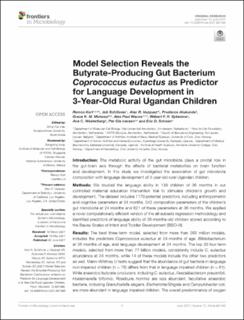| dc.description.abstract | Introduction: The metabolic activity of the gut microbiota plays a pivotal role in the gut-brain axis through the effects of bacterial metabolites on brain function and development. In this study we investigated the association of gut microbiota composition with language development of 3-year-old rural Ugandan children.
Methods: We studied the language ability in 139 children of 36 months in our controlled maternal education intervention trial to stimulate children’s growth and development. The dataset includes 1170 potential predictors, including anthropometric and cognitive parameters at 24 months, 542 composition parameters of the children’s gut microbiota at 24 months and 621 of these parameters at 36 months. We applied a novel computationally efficient version of the all-subsets regression methodology and identified predictors of language ability of 36-months-old children scored according to the Bayley Scales of Infant and Toddler Development (BSID-III).
Results: The best three-term model, selected from more than 266 million models, includes the predictors Coprococcus eutactus at 24 months of age, Bifidobacterium at 36 months of age, and language development at 24 months. The top 20 four-term models, selected from more than 77 billion models, consistently include C. eutactus abundance at 24 months, while 14 of these models include the other two predictors as well. Mann–Whitney U tests suggest that the abundance of gut bacteria in language non-impaired children (n = 78) differs from that in language impaired children (n = 61). While anaerobic butyrate-producers, including C. eutactus, Faecalibacterium prausnitzii, Holdemanella biformis, Roseburia hominis are less abundant, facultative anaerobic bacteria, including Granulicatella elegans, Escherichia/Shigella and Campylobacter coli, are more abundant in language impaired children. The overall predominance of oxygen tolerant species in the gut microbiota was slightly higher in the language impaired group than in the non-impaired group (P = 0.09).
Conclusion: Application of the all-subsets regression methodology to microbiota data established a correlation between the relative abundance of the anaerobic butyrate-producing gut bacterium C. eutactus and language development in Ugandan children. We propose that the gut redox potential and the overall bacterial butyrate-producing capacity in the gut are important factors for language development. | en_US |

